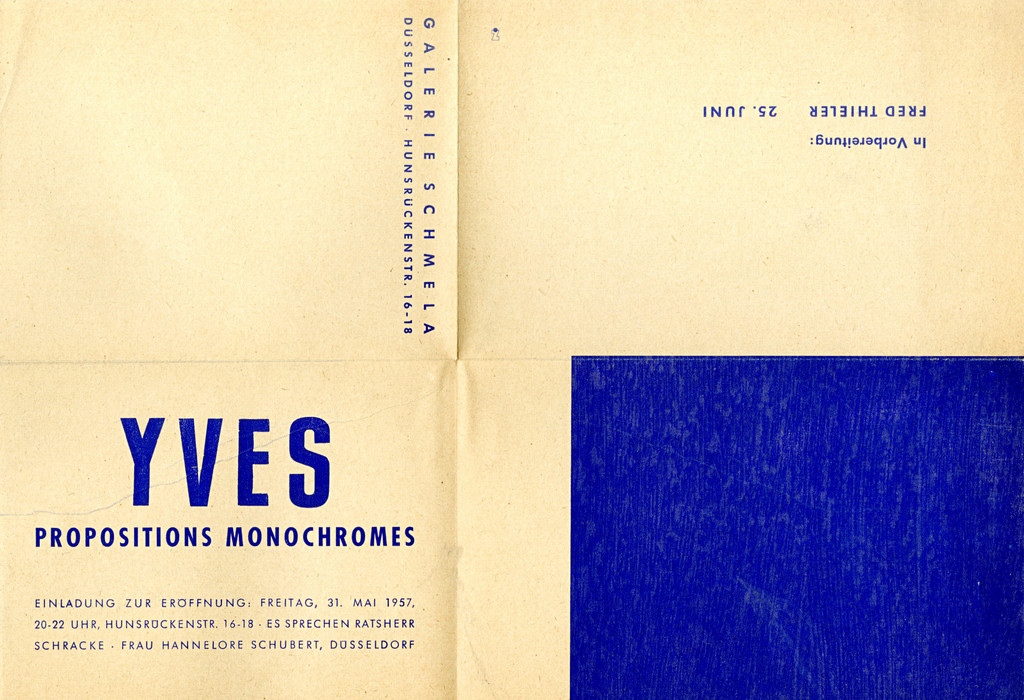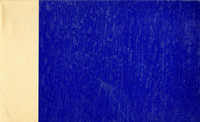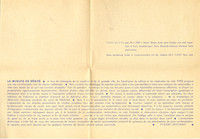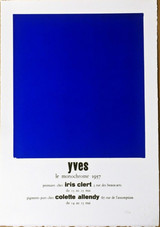
An Educated Collector is Our Best Client
In business for nearly two decades, we are a well established, popular contemporary art boutique specializing in expertly chosen, blue chip prints, multiples, uniques, books, ephemera and merchandise at different price points, with a focus on the secondary market. Please click on the "Contact Us" button at the bottom of this page for questions about any work, pricing and/or to arrange to visit our showroom/gallery - located in between Manhattan's Flatiron and Chelsea Flower Districts.
Yves Klein, Yves Klein Propositions Monochromes with IKB (International Klein Blue), 1957
CONTACT GALLERY FOR PRICE
Description
Yves Klein
Yves Klein Propositions Monochromes with IKB (International Klein Blue), 1957
Extremely rare silkscreen vintage invitation with IKB for Galerie Schmela exhibition
Not signed
8 1/4 × 11 3/4 inches
Unframed
Original Invitation for the exhibition "Yves Propositions Monochromes", Galerie Schmela, Düsseldorf, 31 May - 23 June 1957. Good luck finding another one of these extremely rare, valuable and highly collectible invitations anywhere else in the world. This is the LIFETIME invitation to Yves Klein's landmark 1957 exhibition at Galerie Schmela in Dusseldorf. The invitation features the artist's legendary patented blue color IKB (International Klein Blue). It is in good vintage condition, with the original folds as issued.
Publisher:
Galerie Schmela
About Yves Klein:
Artist, theorist, and provocateur, Yves Klein was a wide-ranging thinker who worked in painting, sculpture, performance, photography, music, architecture, and criticism. His name is often linked to the European avant-garde group Nouveau Réalisme (New Realism), but Klein was not a true realist. Instead, he aimed to reimagine the world in spiritual terms through an exploration of color, light, and space. Although his career lasted only eight years, he produced a groundbreaking body of work that is considered seminal for the later development of both Minimalism and performance art.
Klein was born in Nice, France, to parents who were both painters. During the 1940s, before deciding to become an artist, he taught Spanish, explored the esoteric doctrine of Rosicrucianism, and made a serious study of judo, earning a black belt in 1953.
In 1955, Yves Klein had his first public showing of his monochrome oil paintings, presenting a new and controversial form of abstraction that only featured a single color. At the Club des Solitaires in Paris, Klein adorned the walls with intensely vibrant canvases in colors like magenta, yellow, red, and blue. His objective, to fully reject representation in art, was completely misunderstood by the audience, even a year later when Klein presented these works again at Galerie Colette Allendy. These early viewers interpreted the works as a splashy new style of interior decorating. Klein, disappointed but not deterred, instead turned further toward monochrome, later calling the style an “open window to freedom.” He worked with a chemist to formulate and patent his very own color for these paintings—a strikingly saturated ultramarine blue, which he named International Klein Blue (IKB). Satisfied with the color’s ability to transcend the material world, Klein spent the rest of his career creating monochrome canvases, reliefs, sculptures, furniture, and even balloons in this signature color.
In 1958, Klein staged an exhibition entitled The Void. Visitors entered through curtains dyed in IKB only to encounter a nearly empty gallery that Klein had painted pure white. In 1960, he performed a Leap Into the Void. A photograph of the event appears to show “the painter of space” flying ecstatically into the sky from the roof of a building in suburban Paris. But the document was faked. Klein did jump off the roof, but he had arranged for a group of friends to catch him with a tarpaulin. Two negatives—one showing the jump, and the other showing the empty street—were printed seamlessly together to make the photograph, which Klein distributed on newsstands in a self-published broadsheet entitled Dimanche. Le journal d’un seul jour (Sunday. The Newspaper of One Day). For Klein, the void did not represent emptiness; instead, it signified complete artistic and spiritual freedom.
In 1961, the Museum Haus Lange in Krefeld, West Germany, opened a large exhibition entitled Yves Klein: Monochrome and Fire. Klein himself designed the installation, placing at the center a small room dedicated to “the void,” which was so flooded with white light that the space seemed to dematerialize. The room was left intact and is today a place of pilgrimage for students of Klein’s work.
Klein’s Anthropometries, a series he began in 1960, also merged painting and performance. Nude female models were smeared with IKB paint and used as “living brushes” to make body prints on prepared sheets of paper or canvas. The Walker’s collection includes Suaire de Mondo Cane (Mondo Cane Shroud) (1961), one of Klein’s last Anthropometries. The Italian director Gualtiero Jacopetti documented its creation for his film Mondo Cane, which premiered at the 1962 Cannes Film Festival. When Klein saw the film, he found to his horror that it did not present his Anthropometries as serious art but as an example of shocking, deplorable cultural practices from around the world. Despondent and humiliated, Klein died of a heart attack a few weeks later. Today he is recognized as a pivotal figure who pushed postwar art in new directions by questioning both the physicality of the art object and the role of the artist.











